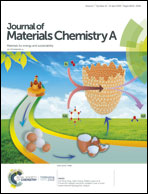Mesoporous silica nanoplates facilitating fast Li+ diffusion as effective polysulfide-trapping materials for lithium–sulfur batteries†
Abstract
Nanostructured functional interlayers and separators have potential applications in high-performance lithium–sulfur (Li–S) batteries, due to their ability to suppress polysulfide (PS) shuttling. However, effective PS-trapping designs are usually accompanied by limited Li-ion diffusion, which becomes a key issue hindering practical application. Here, a nitrogen-functionalized 2D mesoporous silica nanoplate (FMSiNP) was used to construct a dense, lightweight (<0.2 mg cm−2) multi-functional interlayer using a simple casting approach, which effectively suppressed the PS shuttling, while facilitating Li+ diffusion. Being able to synergistically combine the merits of strong PS trapping with fast Li+ diffusion and excellent electrolyte wettability, Li–S batteries with FMSiNP coated-interlayers show improved PS utilization and retention. These batteries additionally show a superior cycling stability, capacity fading rate (0.038% per cycle at 1.0C over 1500 cycles), a high rate performance (discharge capacity of 574 mA h g−1 at 4.0C), low self-discharge behaviour and a high areal capacity (2.48 mA g cm−2 over 100 cycles), when using a pure sulfur/carbon black (CB) mixture as a cathode. This rational design for multi-functional interlayers provides a facile and effective strategy to create high energy density Li–S batteries for practical applications.



 Please wait while we load your content...
Please wait while we load your content...